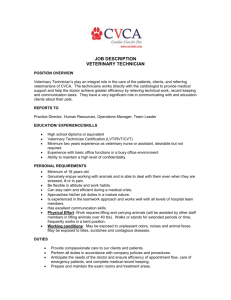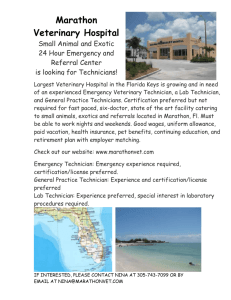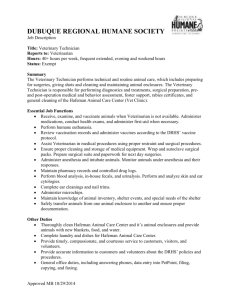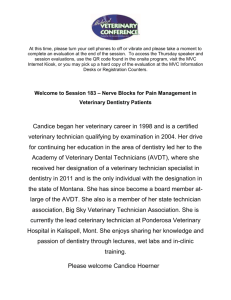Vet Tech Skills List
advertisement
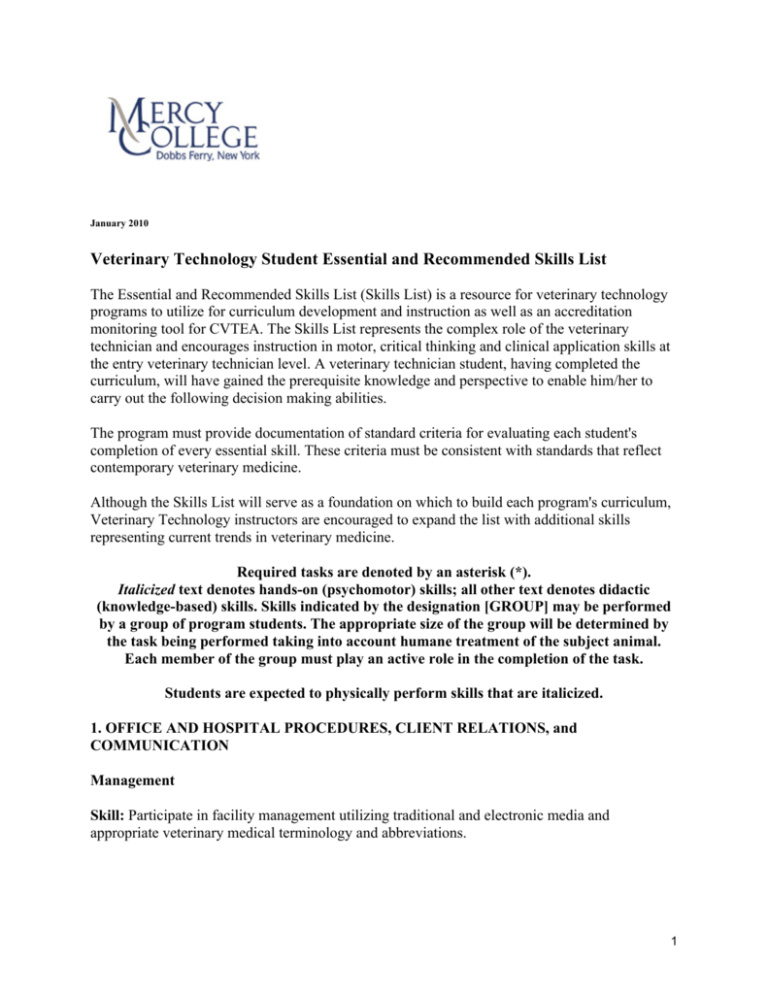
January 2010 Veterinary Technology Student Essential and Recommended Skills List The Essential and Recommended Skills List (Skills List) is a resource for veterinary technology programs to utilize for curriculum development and instruction as well as an accreditation monitoring tool for CVTEA. The Skills List represents the complex role of the veterinary technician and encourages instruction in motor, critical thinking and clinical application skills at the entry veterinary technician level. A veterinary technician student, having completed the curriculum, will have gained the prerequisite knowledge and perspective to enable him/her to carry out the following decision making abilities. The program must provide documentation of standard criteria for evaluating each student's completion of every essential skill. These criteria must be consistent with standards that reflect contemporary veterinary medicine. Although the Skills List will serve as a foundation on which to build each program's curriculum, Veterinary Technology instructors are encouraged to expand the list with additional skills representing current trends in veterinary medicine. Required tasks are denoted by an asterisk (*). Italicized text denotes hands-on (psychomotor) skills; all other text denotes didactic (knowledge-based) skills. Skills indicated by the designation [GROUP] may be performed by a group of program students. The appropriate size of the group will be determined by the task being performed taking into account humane treatment of the subject animal. Each member of the group must play an active role in the completion of the task. Students are expected to physically perform skills that are italicized. 1. OFFICE AND HOSPITAL PROCEDURES, CLIENT RELATIONS, and COMMUNICATION Management Skill: Participate in facility management utilizing traditional and electronic media and appropriate veterinary medical terminology and abbreviations. 1 Tasks: Schedule appointments, admit, discharge and triage according to client, patient and facility needs through phone and in-person contact* o Recognize and respond to veterinary medical emergencies* Create and maintain individual client/patient records, vaccination certificates, and other appropriate forms*: o develop computer skills* o be able to utilize common management software programs* o be familiar with veterinary on-line services* Perform basic filing of medical records, radiographs, lab reports, etc.* Create and maintain all appropriate facility records and logs in compliance with regulatory guidelines (e.g., radiography, surgery, anesthesia, laboratory, controlled substance)* Manage inventory control* Recognize roles of appropriate regulatory agencies* Maintain appropriate disposal protocols for hazardous materials* Establish and maintain appropriate sanitation and nosocomial protocols for a veterinary facility, including patient and laboratory area* Handle routine financial transactions* Decision-making abilities: Taking into account the characteristics of the facility, patients and clients, the veterinary technician will effectively contribute to the professional and efficient operation of the facility in order to provide maximum benefits to clients, patients, and the facility. Communication Skill: Communicate in a professional manner in all formats - written, oral, non-verbal, and electronic. Tasks: Apply understanding of interpersonal skills and team dynamics in all aspects of team dynamics* Utilize appropriate interpersonal and public relations skills* Demonstrate telephone etiquette* Recognize the legality of the veterinary-client-patient relationship* Develop and provide client education in a clear and accurate manner at a level the client understands (i.e., oral and written form, including educational handouts)* Apply crisis intervention/grief management skills with clients* Decision-making abilities: Taking into account the patient, client, staff and circumstances, the veterinary technician will effectively and accurately acquire and convey information utilizing an appropriate communication mode. 2 Laws and Ethics Skill: Follow and uphold applicable laws and the veterinary technology profession's ethical codes to provide high quality care to patients. Tasks: Understand and observe legal boundaries of veterinary health care team members* Interact professionally with clients and fellow staff members* Demonstrate a commitment to high quality patient care* Respect and protect the confidentiality of client and patient information* Decision-making abilities: Given knowledge of legal limitations and applicable ethical standards, the veterinary technician will carry out her/his duties within appropriate legal boundaries and maintain high ethical standards to provide high quality service to clients, patients, employers and the veterinary profession. 2. PHARMACY and PHARMACOLOGY Administration Skill: Safely and effectively administer prescribed drugs to patients. Tasks: Prepare medications; label and package dispensed drugs correctly* Read and follow veterinarian's pharmacy orders* Recognize groups of drugs, their mechanisms, and clinically relevant side effects* Recognize the safe and effective manner in which vaccines must be administered; recognize and explain common side effects* Accurately perform appropriate calculations; use weights and measures correctly* Safely and effectively administer drugs by common parenteral and enteral routes; be able to explain appropriate routes and methods and when used* Monitor therapeutic responses* Demonstrate the ability to accurately record medical information* Demonstrate understanding of regulations governing maintenance of controlled substances log book* Demonstrate compliance with all federal regulatory guidelines for drug purchase, storage, administration, withdrawal, dispensing, disposal, and inventory control (e.g., biologics and therapeutic agents, pesticides, and hazardous wastes)* Decision-making abilities: Given the characteristics of the patient, the instructions of the veterinarian and the medication to be used, the veterinary technician will calculate the correct amount of medication in the prescribed form and administer it by the prescribed route to maximize therapeutic benefits and minimize the potential for adverse effects. The veterinary technician shall also be able to differentiate between abnormal and normal responses to medication. 3 Dispensing Skill: Accurately dispense and explain prescribed drugs to clients. Tasks: Given a drug order, properly prepare medications for dispensing, including performing accurate calculations* Demonstrate compliance with regulations governing prescription drugs versus over-thecounter drugs* Demonstrate understanding of regulations governing maintenance of controlled substances log book* Demonstrate compliance with all federal regulatory guidelines for drug purchase, storage, administration, withdrawal, dispensing, disposal, and inventory control (e.g., biologics and therapeutic agents, pesticides, and hazardous wastes)* Relay drug information to clients (e.g., handling, storage, administration, side-effects, drug interactions, safety, reasons for use of drug)* Decision-making abilities: Given the characteristics of the patient, the instructions of the veterinarian and the medication to be used, the veterinary technician will (1) accurately calculate and dispense the correct form and dose of medication and (2) communicate necessary client information in order to maximize safety, compliance with prescribed therapy and successful treatment of the patient. The veterinary technician should also be proficient at performing inventory control procedures. 3. NURSING Patient assessment Skill: Demonstrate and perform patient assessment techniques in a variety of animal species. Tasks: Recognize common domestic animal species and breeds* Describe and use common animal identification methods* Demonstrate effective and appropriate restraint techniques for various animal species: o properly restrain dogs and cats for procedures* o encage and remove small animals from cages* o apply dog muzzle safely* o apply Elizabethan collar* o use restraint pole and other restraint aids*[GROUP] o halter, tie, and lead horses* o restrain birds* o restrain pocket pets and exotics o restrain cattle and horses* o apply twitch (horses)*[GROUP] o apply bovine tail restraint* 4 apply bovine halter* o restrain sheep and swine o load large animals o Safely operate cattle chute*[GROUP] Obtain a thorough patient history* Demonstrate the ability to obtain objective patient data: o temperature (dog, cat, horse, cow)* o pulse (dog, cat, horse, cow)* o respiration (dog, cat, horse, cow)* o auscultate heart/lungs* (dog, cat, horse, cow) o assess hydration status Properly collect diagnostic specimens for analysis (ex: urine, blood, feces, specimens for cytology)* • Perform venipuncture: o cephalic (dog, cat)* o jugular (dog, cat, horse, ruminant)* o saphenous (dog)* o medial femoral (dog, cat) o sublingual (dog) o ear (swine, rabbit) o coccygeal (cow) o anterior vena cava (pig) • Collect urine sample: o catheterize male* and female dogs[GROUP] o catheterize female cat o catheterize male cat*[GROUP] o collect voided urine sample (small animal)* o perform cystocentesis (small animal)*[GROUP] o catheterize large animal Prepare diagnostic specimens for shipment* o Decision-making abilities: Given the characteristics of the patient, the veterinary technician will safely and efficiently obtain subjective and objective patient data that will allow accurate evaluation of the patient's physical status with minimum stress and maximum safety. Patient care Skill: Understand and demonstrate husbandry, nutrition, therapeutic and dentistry techniques appropriate to various animal species. Tasks: Husbandry Grooming: o Demonstrate understanding of therapeutic bathing, basic grooming, and dipping of small animals* o trim nails (dogs, cats, birds, exotic/special species)* o trim hooves (ruminant, horses) 5 apply equine tail and leg wraps* express canine anal sacs* clean and medicate ears (dog, cat)* clean sheath (horse) Perform microchip scanning and implantation Environmental conditions: implement sanitation procedures for animal holding and housing areas* Demonstrate understanding of permanent identification* Demonstrate understanding of breeding/reproduction techniques* Demonstrate understanding of care of orphan animals Demonstrate understanding of nursing care of newborns* o o o o Decision-making abilities: Given the characteristics of the patient, the veterinary technician will implement appropriate husbandry techniques to enhance wellness and reduce risk of disease, injury and stress. Tasks: Nutrition Understand life stage energy and nutrient requirements of well animals (dog, cat, horse, cow)* Identify common grains and forages Understand key nutritional factors in disease conditions* o be familiar with therapeutic foods* Understand current developments in nutritional supplements and additives including benefits and potential toxicities* Understand and identify substances that when ingested result in toxicity: o identify common poisonous plants* o be familiar with substances (organic and inorganic) that cause toxicity* Develop and communicate hospital nutrition protocols* Decision-making abilities: Given the characteristics of the patient, the veterinary technician will understand appropriate and inappropriate dietary components for various life stages and therapeutic regimens (e.g., therapeutic foods) in order to promote optimal health, enhance recovery and manage chronic disease conditions. The veterinary technician will also explain nutritional recommendations to clients and reinforce owner compliance Tasks: Therapeutics Administer parenteral medications: o subcutaneous* o intramuscular* o intradermal o intraperitoneal o intramammary (mastitis therapy only) o intravenous* Administer enteral medications: o balling gun (ruminant)* 6 dose syringe (ruminant, horse)* gastric intubation (small animal)*[GROUP] hand pilling (dog, cat)* gastric lavage (dog) dose syringe (pig) oral speculum and stomach tube (ruminant) nasogastric intubation (small animal, horse) Administer topical medications (including eye meds)* Perform ocular diagnostic tests (including tonometry, fluorescein staining and Schirmer tear test)* Administer enemas*[GROUP] Collect/evaluate skin scrapings* Fluid therapy: o administer subcutaneous fluids* o place intravenous catheters (cephalic*, saphenous*, jugular) o maintain and care for catheters* o determine/maintain fluid infusion rate* o monitor patient hydration status* o develop familiarity with fluid delivery systems* Apply and remove bandages and splints* Remove casts Develop understanding of wound management and abscess care* Perform physical therapy: o hydrotherapy o post-operative o orthopedic o neurological o explain care of recumbent patient* Perform critical care: o maintain chest, tracheostomy, pharyngostomy tubes o collect, crossmatch, and give blood transfusions Apply established emergency protocols: o maintain emergency medical supplies/crash cart* o perform first aid and cardiopulmonary resuscitation (simulation acceptable)* o use ambu bag* o apply emergency splints and bandages* o o o o o o o Decision-making abilities: Given the directions of the veterinarian and the characteristics of the patient, the veterinary technician will carry out appropriate therapeutic techniques in order to achieve maximum health benefits for the patient. Tasks: Dentistry Perform routine dental prophylaxis (manual and machine)* Understand client education regarding home care* Float teeth Clip teeth 7 Perform routine dental radiographic imaging techniques Decision-making abilities: Given the characteristics of the patient, the veterinary technician will recognize a patient's dental health status and perform techniques, as prescribed by a veterinarian, appropriate to the species and its condition in order to promote and maintain dental health. 4. ANESTHESIA Patient management Skill: Safely and effectively manage patients in all phases of anesthetic procedures. Tasks: Calculate dosages of appropriate anesthetic-related drugs* Administer anesthetic-related drugs by injection, mask, induction chamber or endotracheal tube* Place endotracheal tubes in patients when appropriate* Utilize clinical signs and appropriate equipment to monitor patient status in all stages of anesthetic procedures (e.g., esophageal stethoscope, Doppler, pulse oximeter)* Evaluate patient and implement and evaluate pain management protocols* Recognize and respond appropriately to patients in compromised states* Perform appropriate resuscitation procedures as needed (e.g., calculate and administer appropriate anesthetic antagonists and emergency drugs as directed)* Complete controlled drug log Decision-making abilities: Given the characteristics of the anesthetic patient and the procedure being performed, the veterinary technician will work with the veterinarian to: 1. Assess the patient's risk status and determine appropriate anesthetic and perianesthetic protocols to provide effective pain management and maximum anesthetic safety and effectiveness. 2. Choose and utilize appropriate techniques and equipment to accurately and effectively monitor the patient's ongoing status before, during and after anesthesia to provide for adequate anesthesia, analgesia and a safe recovery. Equipment/facility management Skill: Safely and effectively select, utilize and maintain anesthetic delivery and monitoring instruments and equipment. Tasks: Maintain and operate anesthetic delivery and monitoring equipment: o pulse oximeter* o esophageal stethoscope* 8 o o o o o o o o o o o electrocardiograph (e.g., recognize abnormal rhythms/audible sounds, properly apply leads)* anesthetic machines, including rebreathing systems, non-rebreathing systems induction chambers and masks* endotracheal tubes* ambu bag* scavenging systems* oxygen sources* respiratory monitors* blood pressure monitoring devices* laryngoscopes* ventilator defibrillator Decision-making abilities: 1. Given the characteristics of the anesthetic instruments and equipment being used, the veterinary technician will recognize and respond appropriately to equipment malfunctions or inappropriate equipment setup in order to ensure proper function and provide maximum benefit to the patient. 2. Given the requirements of the anesthetic protocol, the veterinary technician will select, evaluate and adjust equipment to ensure proper function and provide maximum benefit to the patient. 5. SURGICAL NURSING It is essential that technicians have knowledge of routine surgical procedures and related equipment. Direct involvement with all procedures will not be required, but students should have experience with most of those listed. The following procedures are intended to be suggestive of surgical procedures that may be common in a veterinary practice and the technician's education may not necessarily be limited to the items listed: o o o o o o o o o o ovariohysterectomy - dogs and cats* cesarean section - all common species* orthopedic procedures* castration - all common species* tail docking* onychectomy - dogs and cats* laparotomies - all common species* dystocias in common species* dehorning - cattle and goats* prolapsed organs - common types, species, and incidence* Patient management Skill: Understand and integrate all aspects of patient management for common surgical procedures in a variety of animal species. 9 Task: Properly identify patients and surgical procedures* Decision-making abilities: Given the characteristics of the patient and the surgical procedure to be performed, the veterinary technician will use medical records and patient identification methods to assure that the patient and scheduled procedures are correct. Task: Patient assessment o organize medical records/consent forms* o review pre-operative evaluation* o evaluate current patient status* o coordinate anesthesia* Decision-making abilities: Given the characteristics of the patient and the surgical procedure to be performed, the veterinary technician will obtain the patient's vital signs, note any specific physical abnormalities, ensure pre-surgical tests have been completed and report the patient assessment to the veterinarian. Task: Prepare surgical site using appropriate aseptic techniques* Decision-making abilities: Given the characteristics of the patient and the surgical procedure to be performed, the veterinary technician will identify the appropriate area of hair to be removed and select appropriate methods to reduce microbial flora on the skin in the area of surgical site in order to decrease the chance of surgical wound contamination. Task: Position patient for common procedures* Decision-making abilities: Given the characteristics of the patient and the surgical procedure to be performed, the veterinary technician will position the patient appropriately to provide maximum convenience for the surgeon and maximum safety and benefit for the patient. Task: Provide surgical assistance: o maintain proper operating room conduct and asepsis* o assist with care of exposed tissues and organs* o properly pass instruments and supplies* o operate and maintain suction and cautery machines* o understand the principles of operation and maintenance of fiber optic equipment* o keep operative records* 10 o perform basic suturing techniques Decision-making abilities: Given the characteristics of the patient and the surgical procedure to be performed, the veterinary technician will understand and utilize appropriate aseptic techniques to assist operative personnel in order to provide maximum safety and benefit to the patient. Task: Coordinate pain management with the anesthesia/surgical team* Decision-making abilities: Given the characteristics of the patient and the surgical procedure to be performed, the veterinary technician will assure that anesthetic and post-operative pain management protocols are appropriate to provide maximum safety and benefit to the patient. Task: Provide post-operative care: o pain management* o fluid therapy* o adequate nutrition* o wound management* o bandaging* o discharge instructions* o suture removal* Decision-making abilities: Given the characteristics of the patient and the surgical procedure to be performed, the veterinary technician will understand and administer the appropriate methods of post-operative care to assure maximum safety and benefit to the patient. Procedural management Skill: Understand and provide the appropriate instruments, supplies and environment to maintain asepsis during surgical procedures. Tasks: Prepare surgical instruments and supplies* Prepare gowns, masks, gloves, and drapes* Operate and maintain autoclaves* Sterilize instruments and supplies using appropriate methods* Identify and know proper use for instruments* Identify common suture materials, types, and sizes* Provide operating room sanitation and care* Maintain proper operating room conduct and asepsis* Perform post-surgical clean-up (e.g., equipment, instruments, room, proper disposal of hazardous medical waste)* 11 Decision-making abilities: Given the characteristics of the patient and the surgical procedure to be performed, the veterinary technician will properly select, wrap and sterilize appropriate instruments and supplies and prepare and maintain the surgical environment to ensure maximum safety and benefit to the patient. 6. LABORATORY PROCEDURES Specimen management Skill: Properly package, handle and store specimens for laboratory analysis. Tasks: Prepare specimens for diagnostic analysis* Select and maintain laboratory equipment* Implement quality control measures*[GROUP] Ensure safety of patients, clients and staff* Decision-making abilities: 1. Given the characteristics of the patient and the requested analysis, the veterinary technician will properly prepare, handle and submit appropriate samples for diagnostic analysis in order to ensure maximum accuracy of results. 2. Given the characteristics of laboratory instruments and equipment, the veterinary technician will determine proper maintenance and quality control procedures necessary to ensure accurate results. Specimen analysis Skill: Properly carry out analysis of laboratory specimens. Tasks: Perform urinalysis: o determine physical properties (e.g., color, clarity, specific gravity)* o test chemical properties* o examine and identify sediment* Perform CBC: o hemoglobin* o packed cell volume* o total protein* o white cell count* o red cell count* Perform microscopic exam of blood film: o prepare film and stain using a variety of techniques* o perform leukocyte differential – normal vs abnormal* o evaluate erythrocyte morphology – normal vs abnormal* 12 estimate platelet numbers* calculate absolute values* correct white blood cell counts for nucleated cells* Calculate hematolgic indices* Perform reticulocyte count* Perform platelet count* Coagulation tests – perform one of the following*:[GROUP] o buccal mucosal bleeding time o activated clotting time (ACT) o prothrombin time (PT) o partial thromboplastin time (PTT) o fibrinogen assay Perform blood chemistry tests (BUN, glucose, common enzymes)* Perform serologic test (ELISA, slide/card agglutinations)* Identify blood parasites: o Dirofilaria sp/Dipetalonema sp – antigen kit*, direct*, filter, Knotts o Hemotropic Mycoplasma sp* (formerly Haemobartonella sp) o Anaplasma sp o Babesia sp o Trypanosoma sp o Eperythrozoan sp o Ehrlichia sp Perform parasitologic procedures for external parasites and identify: o mites* o lice* o ticks* o fleas* o flies* Perform diagnostics procedures for parasites: o Antigen kit*, direct*, filter, Knotts o floatation solution preparation o fecal flotations* o fecal sedimentation* o direct smears* o centrifugation with flotation* o adhesive tape retrieval of pinworm ova Identify common parasitic forms: o Nematodes* o Trematodes* o Cestodes* o Protozoa* Perform coprologic tests Perform microbiologic procedures/evaluations: o collect representative samples* o culture bacteria and perform sensitivity tests* o identify common animal pathogens using commercially available media and reagents*[GROUP] o o o 13 collect milk samples and conduct mastitis testing (e.g., CMT, bacterial culture)*[GROUP] o perform common biochemical tests*[GROUP] o perform staining procedures* o culture and identify common dermatophytes* Perform cytologic evaluation o assist in collecting, preparing and evaluating transudate, exudate and cytologic specimens (joint, cerebrospinal, airway, body cavity) o perform fine needle tissue aspirates and impression smear preparation (differentiate benign vs. malignant) o prepare and stain bone marrow specimens o collect, prepare, and evaluate ear cytology* o collect, prepare, and evaluate canine vaginal smears*[GROUP] o evaluate semen o understand timing and types of pregnancy testing o assist with artificial insemination Perform necropsy procedures: o perform a postmortem examination or dissection on non-preserved animal*[GROUP] o collect samples, store and ship according to laboratory protocols*[GROUP] o explain how to handle rabies suspects and samples safely* o handle disposal of dead animals o perform humane euthanasia procedures o Decision-making abilities: 1. Given the characteristics of the patient, the specimen submitted and the results of the analysis, the veterinary technician will be able to recognize accurate vs. erroneous results in order to provide maximum diagnostic benefit. 2. Given the laboratory specimen collected and characteristics of the patient, the veterinary technician will determine appropriate methodology and carry out analytical procedures necessary to provide accurate and precise diagnostic information. 3. Having determined the accuracy of analytical results, the veterinary technician will work with the veterinarian to determine if a need exists for additional laboratory tests that will provide useful diagnostic information. 7. IMAGING Skill: Safely and effectively produce diagnostic radiographic and non-radiographic images. Tasks: Implement and observe recommended radiation safety measures* Implement radiographic quality control measures* Develop and properly utilize radiographic technique charts*[GROUP] Position dogs, cats, horses, and birds for radiographic studies* Demonstrate an understanding of the modifications of diagnostic imaging techniques as they apply to mice, rats, guinea pigs, lizards, and amphibians* 14 Utilize radiographic equipment to expose radiograph film (dental, stationary* and portable units*) Process exposed films to create diagnostic radiographic images (automatic*, hand, and digital processing) Label, file, and store film* Complete radiographic logs, reports, files and records* Perform radiographic contrast studies — perform one of the following*:[GROUP] o GI Series o Pneumocystogram o Intravenous urogram o Other Perform radiographic techniques utilized in screening for canine hip dysplasia*[GROUP] Demonstrate proper maintenance of radiographic equipment, including recognition of faulty equipment operation* Use ultrasonography equipment Use endoscopic equipment Decision-making abilities: 1. Given the characteristic of the patient and the radiographic study that has been requested, the veterinary technician will properly (1) prepare radiographic and darkroom equipment, (2) measure and position animals using topographic landmarks, (3) choose an appropriate radiographic technique to minimize the need for repeat exposures (4) produce the latent image, (5) process the exposed film, (6) analyze the final radiograph for quality in order to provide maximum diagnostic benefit. 2. Given a radiograph, the veterinary technician will be able to determine if the image is of diagnostic quality. If the image is not diagnostic, the veterinary technician will be able to offer options to correct deficiencies in order to provide maximum diagnostic benefit and minimize personnel radiation exposure from unnecessary repeat exposures. 3. Given knowledge of the health risks associated with radiographic procedures and effective safety procedures, the veterinary technician will exercise professional judgement to minimize risks to personnel and patients during radiographic procedures to ensure safety. 4. Given the characteristics of the patient and the non-radiographic imaging study that has been requested, the veterinary technician will properly (1) prepare the imaging site and equipment and (2) position patients appropriately for the study being conducted. 8. LABORATORY ANIMAL PROCEDURES Skill: Safely and effectively handle common laboratory animals used in animal research. Tasks: Mice, rats, and rabbits Recognize and restrain* Determine sex and understand reproduction* Perform and/or supervise basic care procedures: o handling* o nutritional needs/diet* 15 watering* feeding* identification* Administer drugs or medicaments using appropriate sites and routes (all common species)* Perform methods of injection: o subcutaneous* o intramuscular o intradermal o intraperitoneal (rats,mice)* o intravenous o retro-orbital Collect blood samples*[GROUP] Perform oral dosing*[GROUP] Have working knowledge of anesthetic and recovery procedures* Explain common disease signs* Perform necropsy and collect specimens Clean and medicate ears (rabbit) Anesthetize mice, rats, and rabbits o o o Tasks: Non-human primates Understand restraint of non-human primates Demonstrate knowledge of zoonotic diseases and modes of transmission Decision-making abilities: The veterinary technician will be familiar with the basic principles of animal research and understand the utilization of laboratory animals in animal research. The veterinary technician will also have a working knowledge of federal, state, and local animal welfare regulations. 9. AVIAN, EXOTIC, SMALL MAMMALS & FISH PROCEDURES Skill: Understand the approach to providing safe and effective care for birds, reptiles, amphibians, guinea pigs, hamsters, gerbils, and ferrets. Tasks: Recognize, understand, and perform restraint techniques of birds*, reptiles, amphibians, rabbits and ferrets Understand unique husbandry issues for each species (birds, reptiles, amphibians, guinea pigs, hamsters, gerbils, and ferrets) and provide client education*: o nutritional needs/diet o watering o caging (temperature, humidity, light) o aquarium care o understand reproduction o basic grooming (beak, wing, and nail clipping) o appropriate transportation methods 16 Demonstrate the ability to obtain objective data: birds*, reptiles, amphibians, and ferrets Perform injections using appropriate sites o subcutaneous o intramuscular o intradermal o intraperitoneal o intravenous Perform oral dosing Administer or inject drugs using appropriate sites Understand appropriate sites for catheter placement Understand tube feeding in birds Perform laboratory procedures Anesthetize avian and exotic animals Recognize normal and abnormal behavior patterns Explain inadvisability of keeping wildlife as pets Collect blood samples Decision-making abilities: Given the unique requirements of these species, the veterinary technician will safely obtain subjective and objective data that will allow evaluation of the patient. The veterinary technician will be able to: 1) identify husbandry issues, 2) discern appropriate from inappropriate nutritional support, and 3) recognize normal from abnormal behavior patterns. 17

